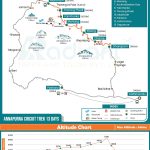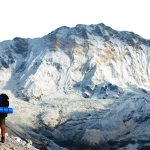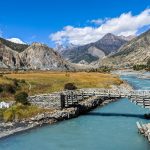Imagine waking up to snow-capped peaks amid crisp air and starting your day to the soft music of prayer flags fluttering in the wind. Welcome to Manang, a mountain sanctuary where nature and culture blend beautifully.
Manang, located at an altitude of 3,519 m, is where the Annapurna Circuit truly comes alive. It is a key acclimatization stop before the trekkers of the Annapurna Circuit Trek cross the Thorong La Pass (5,416 m). Most trekkers spend one or two nights here.
However, you do not need to complete the full circuit to reach this high altitude, as short treks only to Manang are also possible. For those who dislike walking, the Manang jeep tours offer an alternative to travel by road.
What is so special about Manang that people want to be at this particular place only? The first thing is the visual spectacle. Despite being a rugged mountain terrain, Manang is beautifully carved into the Himalayas. It sits in the rain shadow of the Annapurna range and offers breathtaking views of Annapurna II, III and IV along with Gangapurna.
Hikes to Tilicho Lake, Ice Lake, Gangapurna Lake and visits to Praken Gompa add value to your Manang journey.
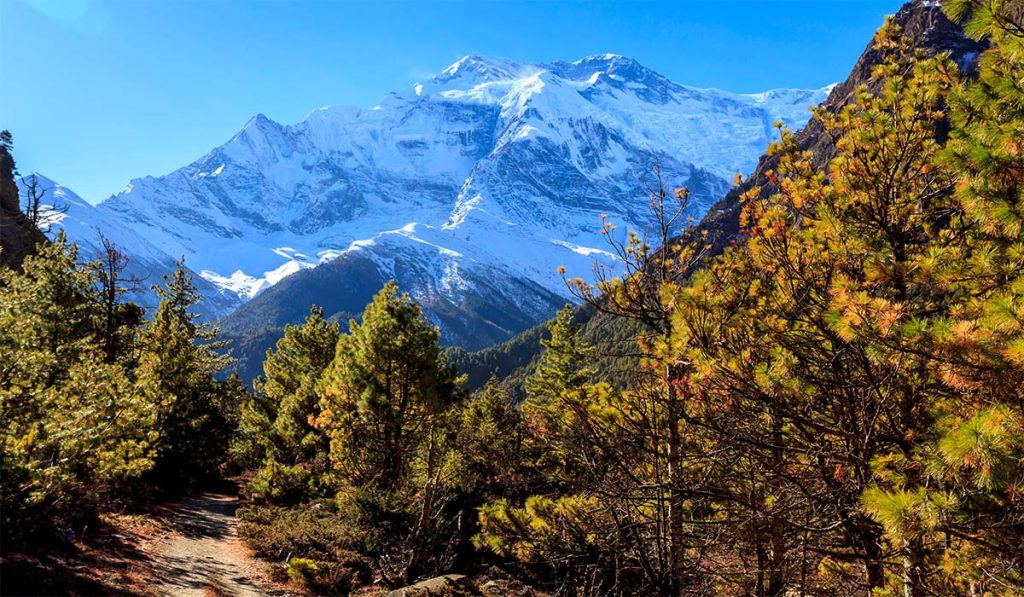
In addition, Manang is also a cultural treasure with its Tibetan-influenced traditions on display. It is a home to the Manangi people, who have preserved their culture and identity for decades.
Along with witnessing their stone-built houses, exploring ancient monasteries and taking part in the Yartung festival, one can get closer to the people and community.
However, that does not mean Manang lacks modern amenities. Visitors can find comfortable teahouses, nice bakeries and cafes along with medical facilities.
So, if you are looking for raw mountain wilderness amidst comfort, then the Manang Annapurna Circuit is the place for you to be.
Highlights
- Scenic journey to Manang village on the Annapurna Circuit trek
- Option to undertake an independent trip to Manang and its surroundings only
- Make Manang an important stop for acclimatization and exploration as a part of the trek to the Annapurna Circuit
- Side trips to Tilicho Lake, Ice Lake, Milarepa Cave, and Gangapurna Lake
- Multiple travel options – trekking from Dharapani or a jeep ride to Manang
- Exploration of authentic Tibetan-influenced culture
- Visit to the ancient Braga Monastery, as well as the traditional settlement of Braga village
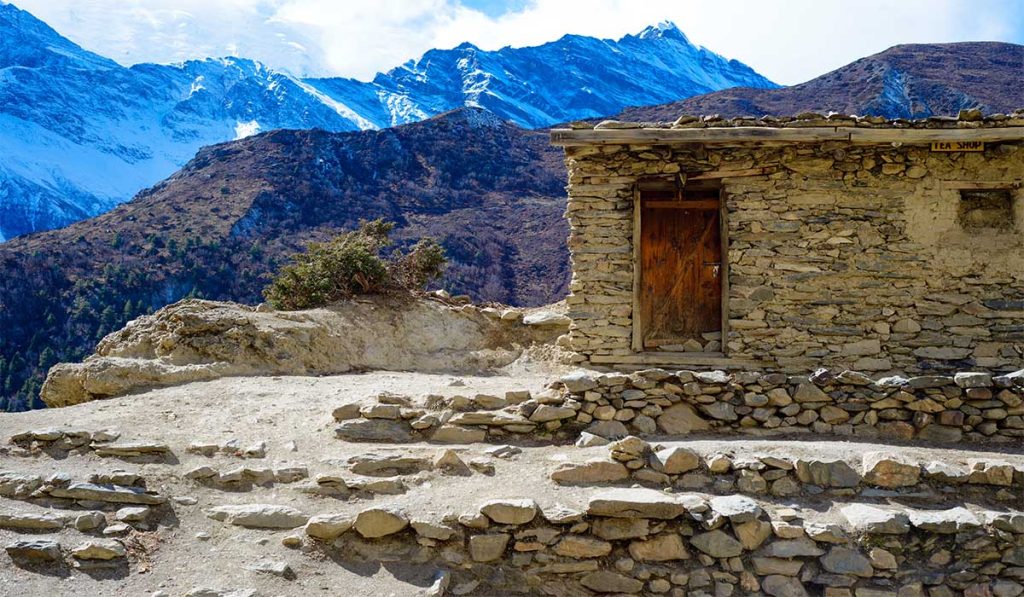
All About Manang
Manang is a remote village located in the Annapurna region of north-central Nepal. It lies in the Manang district of Gandaki Province and is close to the Tibetan border.
As it is in the rain shadow of the Annapurna range, the landscape of Manang is dry, and like that of a desert.
Himalayan peaks like Annapurna II, III and IV, along with Gangapurna, surround this picturesque village. Meanwhile, the natural landscape forms a barrier, which has resulted in limiting its easy access from major cities and road networks.
The roads connect Manang to the lower regions of the area, like Besisahar. Yet the road is narrow and steep and is affected by landslides or other weather conditions. Even snowfall can cut off access routes to and from Manang in winter.
Nonetheless, despite its isolation, the village has become more accessible in recent years due to the development of roads and trekking trails. As it is a part of the classic Annapurna Circuit Trek, it serves as a key acclimatization stop, along with being a cultural highlight.
How to Reach Manang
Reaching Manang is a part of an adventure itself, and the thrill of the journey depends on how you choose to travel. You can reach there either by trekking or taking a jeep. It thus offers options for both trekkers and travelers who prefer to drive through the rugged landscapes in the Himalayas. Or, it is possible to opt for the combination of both.
Trekking to Manang
Whether Manang is a part of your larger Annapurna Circuit Trek or the main destination of your short journey, reaching there on foot promises a memorable experience. The trek can be done roughly in 7 days if Manang is the only place to explore.
However, if you are looking for a more immersive adventure, then the Annapurna Circuit offers a 13 to 16-day exploration that includes Manang as a stop point. You can even add a few more days to the trip if you wish to trek to Tilicho Lake, one of the highest lakes in the world. Annapurna Circuit Trek with Tilicho Lake is one of the options.
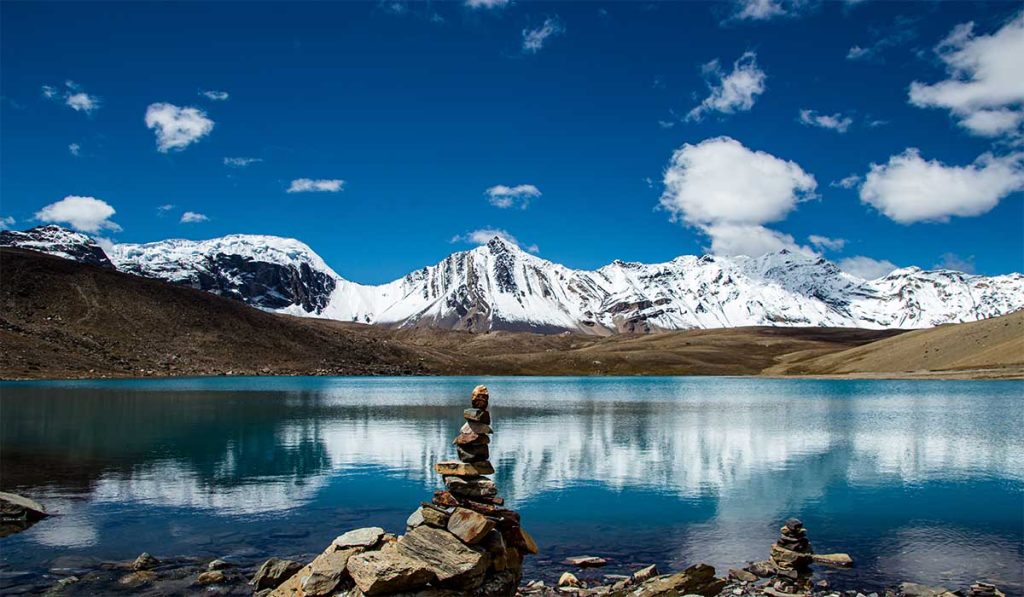
Typically, your journey begins with an arrival at the Tribhuvan International Airport in Kathmandu, followed by a drive to Dharapani. The trek kicks off from Dharapani and you hike to Chame and Pisang before reaching Manang in a few days.
You then explore Manang and return to Kathmandu or continue with your journey of the classic Annapurna Circuit. If you continue onward, you will go to Thorong La Pass and descend to Muktinath before arriving at Pokhara. Then you fly or drive to Kathmandu as per your preference.
You can read the detailed itinerary here.
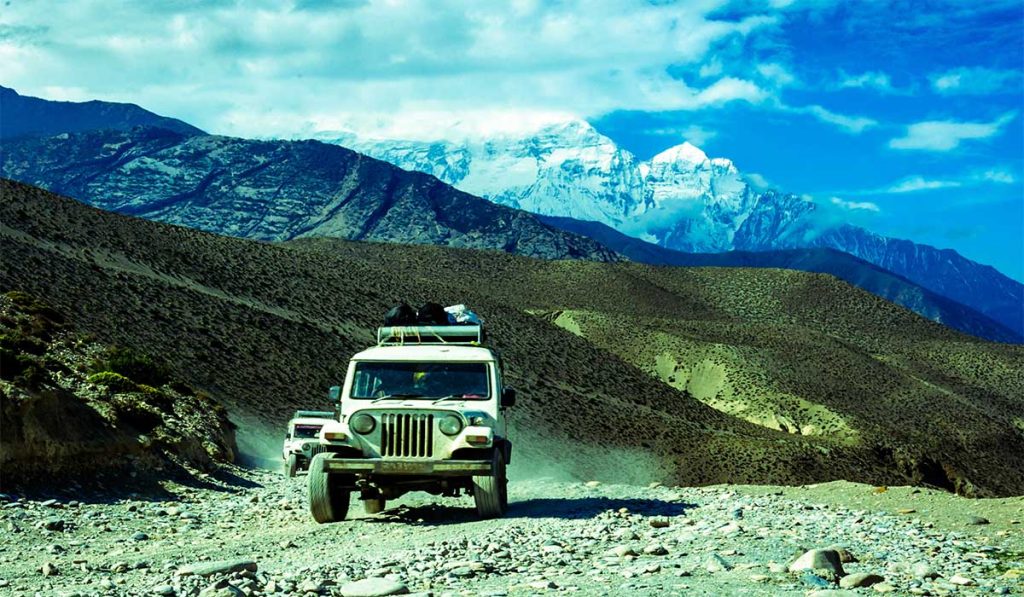
Manang Jeep Tour
If you want to experience remote beauty without committing to a long trek, then traveling to Manang by jeep is the best option for you. As Manang is accessible by road, it is an ideal destination for trekkers looking for a more comfortable approach.
The rough jeep ride to Manang passes through the road crossing suspension bridges, along waterfalls and mountains. The best parts of the journey are very much included even when traveling via the jeep. Also, Manang by jeep is great for those who find it difficult to walk, including senior travelers.
The overland journey of the Manang Annapurna Circuit begins with a drive to Jagat from Kathmandu. Following that, you head to Chame, and then to Manang. The third day of the journey is to explore Manang. After that, you drive back to Besisahar and finally to Kathmandu.
Below is an outline itinerary for the Manang Jeep Tour offered by Radiant Treks:
Day 1: Drive from Kathmandu (1,400 m) to Jagat (930 m) – km, 8 hours
Day 2: Drive from Jagat to Chame (2,670 m) – km, 3 hours
Day 3: Drive from Chame to Manang (3,519 m), 32 km, 2 hours; Explore Manang
Day 4: Drive from Manang to Besisahar (1,430 m), 98 km, 7 hours
Day 5: Drive from Besisahar to Kathmandu (1,400 m), 175 km, 6-7 hours
Many trekkers also use jeep transport to shorten their Annapurna Circuit Trek, starting the hike directly from Chame or Manang. This helps them skip the sections of lower altitude and conserve energy for high altitudes like Thorong La Pass.
If you choose this option, you could ride to Manang by jeep, acclimatize in the village and then trek to Thorong La to Muktinath. This option also allows you to experience the full grandeur of the circuit with added comfort and flexibility.
Are you planning trekking in Nepal? Do you need any information? Let us know via form below, we are happy to help.
Things to Do in Manang
Manang is more than just a stopover on the Annapurna Circuit, as it presents a variety of memorable experiences for visitors. From acclimatization hikes to visits to cultural sites, photography, and local cinema, this place offers a wide range of options to explore.
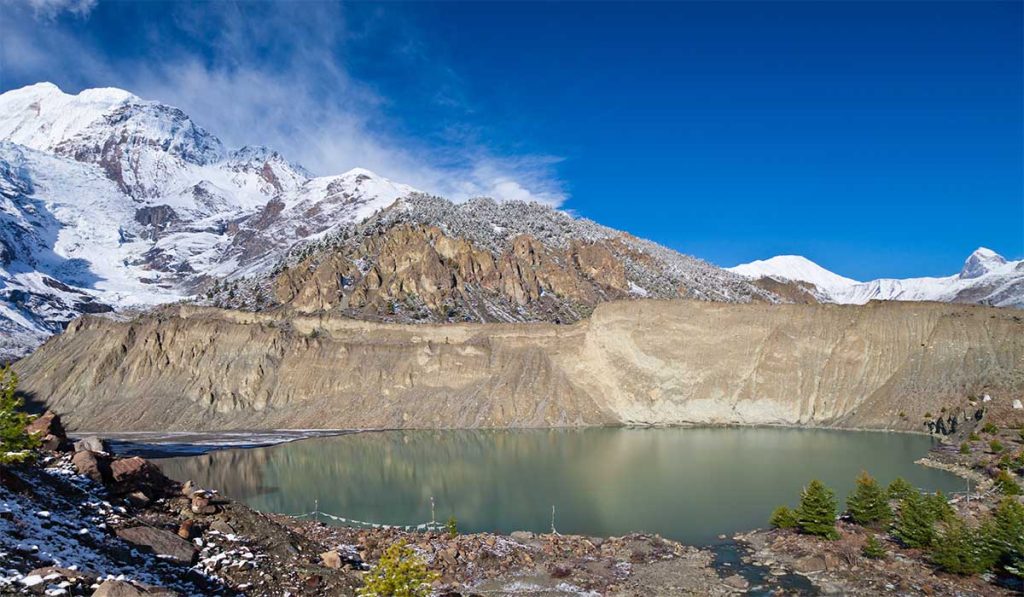
Hike to Gangapurna Lake and Glacier Viewpoint
A short hike of about 1.5 to 2 hours takes you to the Gangapurna Lake at an altitude of 3,540 meters. Originating from the Gangapurna Glacier, the turquoise lake is a visual treat to the visitors hiking there.
You need to walk along a short and moderately steep trail to reach the Lake. There is also a viewpoint above the Lake from where you can see the Gangapurna Glacier, Annapurna III, Tilicho Peak and Marsyangdi River Valley. There is enough time to acclimatize and enjoy the scenery if you set aside around half a day for it.
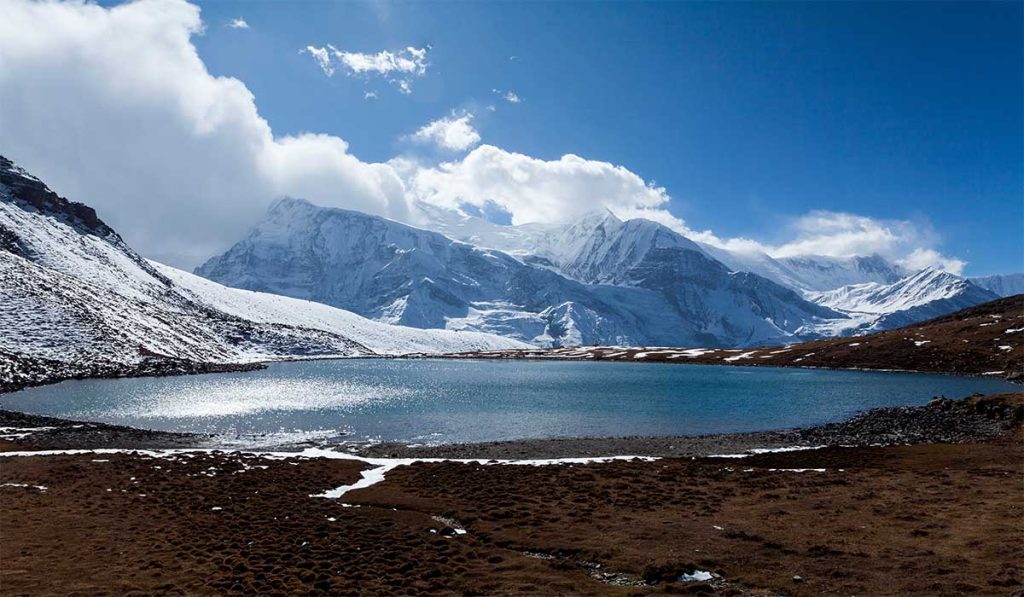
Trip to Ice Lake aka Kicho Tal
One of the popular side trips during the Annapurna Circuit trek or Manang tour is a hike to the Kicho Tal. Situated at an altitude of 4,620 meters, the lake is known for its clear blue water. The lake freezes in winter.
You need to walk for around 5-7 hours to complete the trek. Another perfect destination for acclimatization and exploration, Kicho Tal requires a challenging trek. That is because the climb is continuous, and you need to ascend to a high altitude. Once you make it to the Lake, the views of prayer flags and stone benches welcome you, along with the stunning view of the lake itself.
Visit Milarepa Cave
The Cave is spiritually significant as it is a sacred site where a Tibetan yogi and poet named Milarepa meditated. As a result, this is regarded as a significant pilgrimage site for followers of Tibetan Buddhism.
If you also want to connect with the spiritual energy, then hike for about 3 hours from Manang to arrive at the Milarepa Cave. It is located on a cliffside below Mt. Annapurna III.
An uphill climb along rocky terrain, as well as forests, takes you to this place, which also promises breathtaking videos of the Marsyangdi River. You will also get to enjoy views of different snow-covered mountains and valleys from here.
Hike to Praken Gompa
If you want to explore monasteries, then a hike to Praken Gompa is one of the recommended activities. A round trip of 3 hours completes the journey. To arrive here, you need to ascend north of the Manang village along a well-marked trail.
En route, you are able to enjoy beautiful views of the Annapurna ranges, Gangapurna peak as well as Tare Kang. This short hike is also a destination of acclimatization before heading further on the Annapurna Circuit.
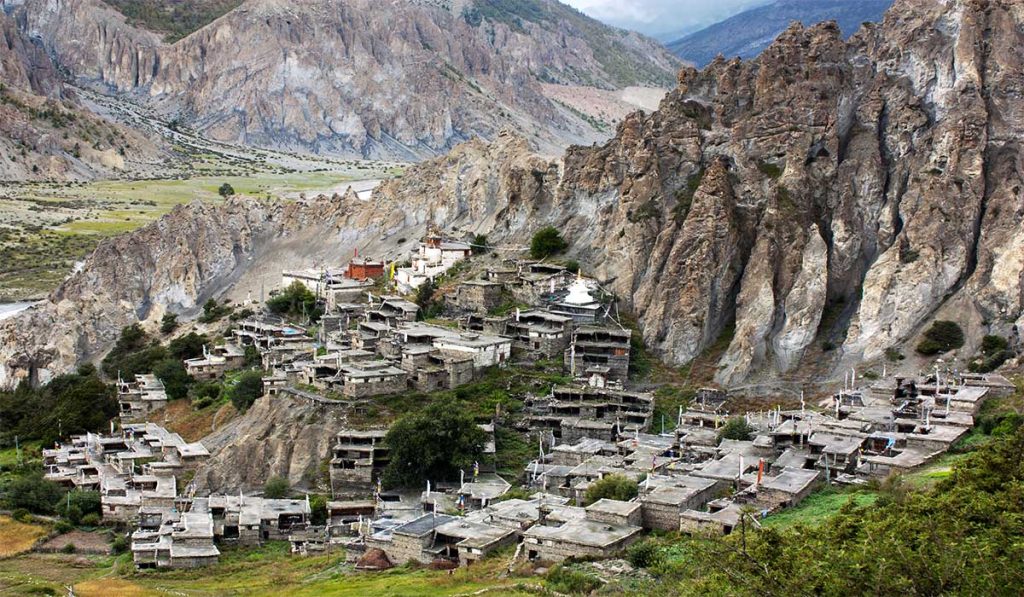
Explore Braga Village
You need to retrace your steps downhill to reach this beautiful village from Manang. Walking for about half an hour, you arrive at the settlement that is home to Braga Gompa. The ancient monastery houses a statue of Guru Rinpoche and some relics. The village itself resembles an ancient settlement due to its stone houses and the traditional lifestyle of the Manangi people.
Trek to Tilicho Lake
It is possible to opt for a trek to Tilicho Lake from Manang if you are ready to add 2-3 additional days in your itinerary. Or you can also join the Annapurna Circuit Trek with Tilicho Lake. This journey requires you to trek to Siri Kharka from Manang. The next day, you arrive at the Tilicho Base Camp at an altitude of 4,150 meters. And the next day, you reach the Tilicho Lake (4,919 m).
The long trekking hours along the rugged terrain can be difficult, but if you are ready for the challenge, then it is a rewarding journey. The world’s highest lake is not only known for its turquoise waters and stunning backdrop for photography, but also for views of the Annapurna and Manaslu ranges.
Other Activities
Despite being a remote destination, Manang is well-known among people visiting here for its good bakeries and cozy teahouses. You can enjoy delicacies like apple pie, chocolate cake, yak cheese pizza, or a cup of coffee here. The teahouses offer a chance to relax while interacting with fellow trekkers.
You may also visit the Manang Culture Museum, which features a collection of masks, costumes, kitchen appliances and a prayer room, among other things. They give a glimpse into the traditional life in Manang.
There is also a small local theater that plays films about altitude sickness and mountain safety. It can be of good use to the trekkers.
Photography
The ancient stone alleys of Manang village provide a good backdrop for photography. The spinning prayer wheels and yak caravans add to the setting of the photo shoots.
In addition, do not forget to capture the sunsets over the Annapurna ranges and surrounding ridgelines. They are the best for perfect photo moments.
Explore Local Culture and Lifestyle
Visiting Manang means exploring local culture and lifestyle as well. You get a chance to witness the rich culture of the Manangi people. They are ethnic people with rich Tibetan Buddhist roots who reside in the region.
A reflection of their faith and lifestyle is evident in the form of chortens, Mani walls and monasteries in the village. Add to that colorful prayer flags and wheels.
Festivals like Yartung are other highlights of Manang. This is celebrated in late August or early September. It brings together communities through activities like horse racing, archery, dancing and drinking.
The locals follow the occupations of farming and yak herding. They grow crops like buckwheat and barley. They also produce and sell yak products.
Traditionally, Manangis are known as traders and yak herders. But today, tourism plays a central role in their livelihood. Many locals are into the hospitality business, running teahouses, bakeries and lodges.
Manangi homes are usually built from stone and mud. These materials offer effective insulation during harsh winter months. But in recent days, modern concrete houses are becoming common in the area.
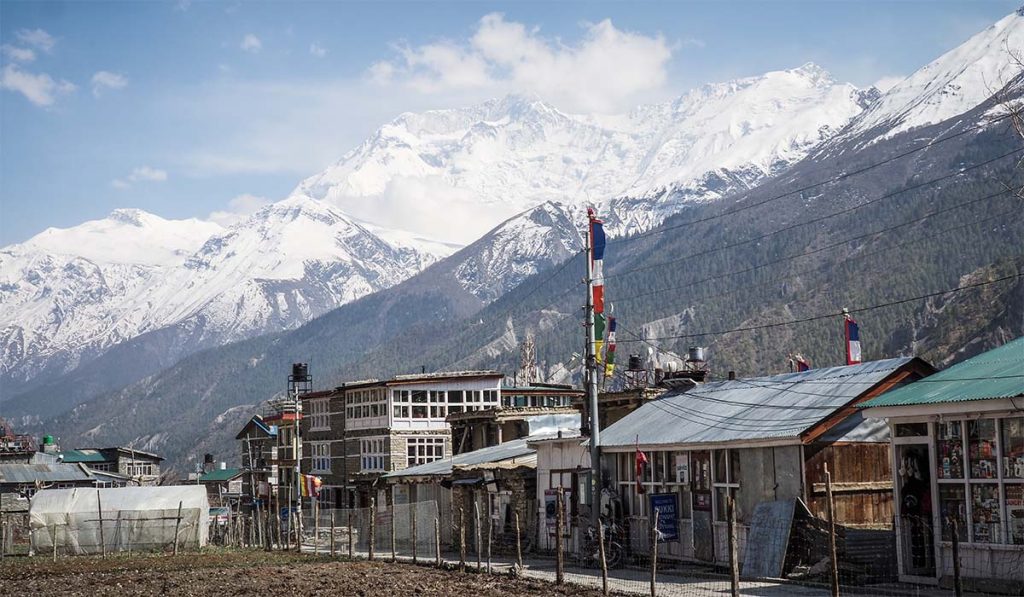
Accommodation, Meal and Other Facilities
Among the many stops on the Annapurna Circuit, Manang offers comfortable tea houses, nutritious meals and basic facilities. You will find better facilities here than in other villages along the route. So, whether you are on a full circuit trek or simply trekking up to Manang, you can look forward to a pleasant stay here.
Accommodation Types
One of the common accommodation facilities in Manang is teahouses. They usually have standard rooms along with twin beds, blankets, pillows and shared toilets.
You can also find dormitories with shared rooms and multiple beds to stay overnight. This is an ideal alternative for large groups as well as budget travelers.
Meanwhile, some upgraded lodges do offer rooms with attached bathrooms as well.
Food and Dining
You need not worry about the availability of good food in this place, as Manang has some of the best dining options on the entire Annapurna Circuit. You have plenty of choices, whether you are looking for traditional Nepali meals or Tibetan dishes or international cuisine.
Dal bhat is served fresh daily with unlimited refills. Pasta, fried rice, pizza, chowmein and pancakes are there to satiate your longing for the taste of home. Thukpa, momo and butter tea add the mountain flavor to your palate.
Along with that, the bakeries offer fresh items, including apple pie and cinnamon rolls. Despite being charged extra, you can buy boiled or filtered drinking water at most tea houses.
Showers, Toilet, Laundry
Gas-heated or solar-heated showers are available after paying an additional cost per shower. Most places offer western-style toilets, but traditional squat toilets still exist in some tea houses.
The shared bathroom is a common thing, with a few lodges featuring attached toilet facilities. Likewise, most lodges offer bucket-wash laundry services, and you are charged either per item or based on the weight of your clothes.
Electricity and Communications
Solar power is common in Manang for electricity generation. You will find charging ports in the dining halls where you can charge your devices. Charging each device costs you a certain amount.
Internet accessed via Wi-Fi is a way of communication. Some teahouses in Manang provide this service. Yet, the internet speed is slow and often unreliable.
You cannot depend on the mobile networks of NTC and Ncell as their networks are either weak or unavailable most of the time.
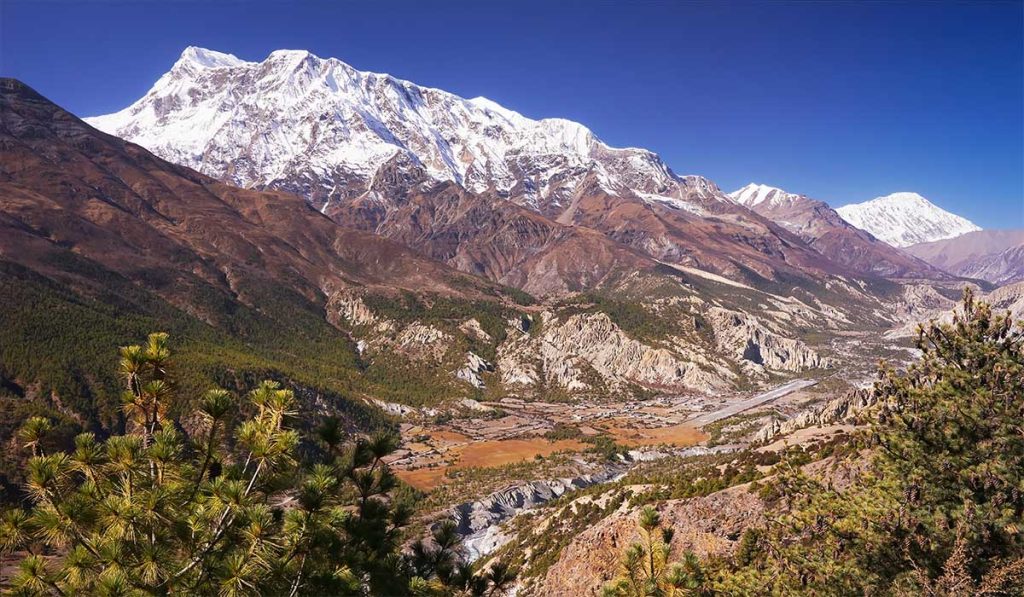
Best Time to Visit Manang
You can visit Manang throughout the year, but the two peak trekking seasons of Nepal provide the best experiences. As such, spring and autumn are the most ideal periods to be in the Manang Annapurna Circuit. Yet each season has its charm in Manang. Read on to explore the weather guide and find out what you are looking for:
Spring: For Nature and Clear views
Spring is, without doubt, one of the best seasons to travel to Mustang due to its pleasant weather. The temperatures are mild during the daytime, ranging between 10°C and 15°C in March, April and May.
This means you feel relaxed on the journey when the temperature is moderate, which eventually allows a comfortable experience. Despite chilly nights, there are fewer disruptions caused by the weather.
Rather, you can see rhododendrons blooming in hillsides, the skies open up, revealing extraordinary mountain views all around. All these factors together create a vibrant atmosphere, contributing to a memorable journey in the Manang Annapurna Circuit.
Autumn: Most Popular Season
Late September to November in Manang offers stable and dry weather along with clear skies. The temperatures are moderate with cool nights. The visibility is so good that you will not miss the panoramic views of Annapurna and Gangapurna ranges along with Tilicho Peak.
Dry weather means drier and firmer trails. Plus, this season provides the best window to cross the Thorong La Pass if you are heading for the Annapurna Circuit Trek.
Meanwhile, the season is marked by some of the major festivals of Nepal, like Dashain and Tihar. It allows the visitors a chance to experience the local culture.
Compared to other seasons, the trails in Manang are crowded in autumn.
Winter: For Adventurers
It is challenging to trek to Manang and beyond in winter, as the temperatures are often below freezing. Heavy snow is expected.
Manang is accessible either via jeep or on foot, but you need to prepare for winter extremities. That is why it is more suitable for adventurers who possess prior experience of trekking in such areas.
Nonetheless, if you happen to reach Manang in December, January, or February, you will be blessed with the views of dramatic winter landscapes. Add to that the quiet trails with fewer trekkers, offering you a journey of solitude.
Monsoon: Accessible Rain Shadow Area
Manang receives relatively less rainfall in the monsoon as compared to other parts of the country. That is because the surrounding mountains serve as a natural barrier, resulting in a rain shadow effect. Therefore, trekking in this area in June, July and August can be a comfortable experience. This is true not only for Manang, but also for other upper parts of the Annapurna Circuit.
Nonetheless, the road to Manang via Besisahar, Jagat, or Chame passes through an area that receives heavy rainfall. This can obstruct the trail as there is a possibility of landslides, mudslides and road blockages.
But if you are planning to fly into Manang by helicopter, then you can escape the monsoon challenges.
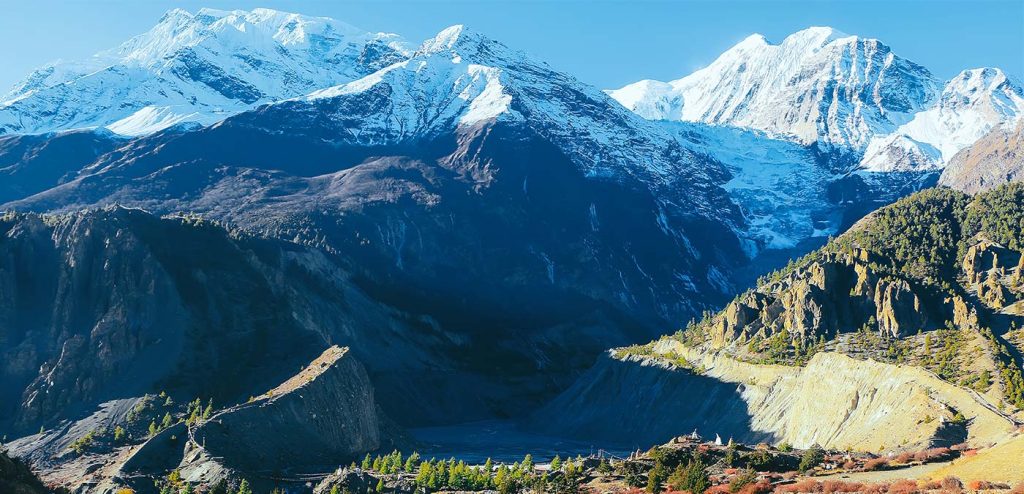
Packing Essentials
One of the keys to enjoying your Manang trip is to pack smartly. That is even more so if you are continuing on the full circuit trek. After all, the trail covers diverse elevations and thus, your gear should be able to address the needs of the changes and challenges:
Layers of clothes
- Moisture-wicking base layers
- Outer layer that is water and windproof
- Trekking pants that dry quickly
- A fleece or down jacket as an insulating layer in the middle
- Thermal wear for high altitudes
- Gloves, a hat and a buff
Multiple Footwear
- Broken-in sturdy trekking boots
- Shoes or sandals to wear in teahouses or lodges
- Multiple pairs of wool or synthetic socks
Gear and Accessories
- Backpack with rain cover
- Sleeping bag rated for -10°C or lower
- Trekking poles
- Reusable water bottles and water purification tablets
- Sunglasses and sunscreen
- Headlamp with extra batteries
Toiletries and First Aid
- Toilet paper and hand sanitizer
- Basic first aid kit
- Altitude sickness medication, like Diamox
- Personal hygiene items
Documents and Money
- Trekking permits
- Passport copies
- Cash in Nepali Rupees
You can pack lighter if you are travelling only to Manang and returning. But if completing the circuit is your goal, then pack carefully to ensure you have carried everything needed for the journey.
Permit Required
If you are attempting to travel to Manang or thinking of a full Annapurna Circuit Trek, you need to obtain a permit beforehand.
As you will be entering a conservation area, you need to acquire the Annapurna Conservation Area Permit. This permit is mandatory for one to enter or trek within the Annapurna Conservation Area. And both the Manang and the Annapurna Circuit fall under the conservation zone.
Radiant Treks helps you obtain the permit free of hassle once you provide us with the needed documents.
Difficulty Level
The mode of travel you choose determines the difficulty of reaching Manang. The challenges and rewards that you face when trekking vary from a jeep ride along this route.
The difficulty level when trekking to Manang can be termed as moderate. The trek from Dharapani to Manang does not require technical skills. Yet, you need to adjust to high altitude as you ascend every day.
From an altitude of 1,860 meters in Dharapani, you climb up to 3,540 meters in Manang. Thus, there is a significant elevation gain and one needs to take a gradual pace to adjust to the altitude changes. In addition, you need to walk for 5 to 8 hours daily as part of the trek to Manang.
But if you are trekking the entire Annapurna Circuit, then there is a whole new challenge. That is especially true when crossing the Thorong La Pass, at an altitude of 5,416 meters. You should expect a challenging trek in this section.
In contrast, the jeep ride is physically easy. The drive from Jagat to Manang can take 6-8 hours and you need to drive along rough and narrow roads. This can be a way to avoid the discomfort of physical trekking.
Yet, as you ascend to over 3,500 meters quickly, there is a chance of experiencing altitude sickness. Therefore, you need to monitor your symptoms to ensure that you are well and safe.
Health and Safety Considerations
Manang is a remote destination at a high altitude. Traveling to this area requires attention to health and safety due to factors like altitude sickness and rough trails.
Whether you are traveling via a jeep or walking, you can feel the effects of altitude in Manang. The risk is higher if you ascend too fast, and that is more likely to happen in a jeep ride if you skip acclimatization.
To prevent the chances of getting altitude sickness, take enough rest and acclimatization days before ascending to higher altitudes. Do not forget to stay hydrated. And avoid alcohol, as it only worsens the symptoms.
Despite the efforts to prevent it, one may show symptoms of headache, fatigue, nausea and shortness of breath. If that happens, one needs to move to a lower elevation. You should carry medicine to prevent symptoms after consulting your physician.
Nonetheless, if the condition gets severe, there is a provision for helicopter evacuation as well. But as it can be expensive, travel with travel insurance that covers high altitude evacuation. This is mandatory even if you are opting for the trek to the Annapurna Circuit.
Carry your first aid kit as well as regular medications. There are pharmacies available at Manang and some urban centers, but the supplies might be limited.
Likewise, to stay safe on the trails that feature loose rocks and narrow paths, carry trekking poles and wear quality footwear.
While traveling via jeep, opt for experienced drivers and a vehicle in good condition. The vehicles should be able to take you comfortably along the narrow and bumpy roads.
FAQs
Do I need to reach Manang when I am trekking the Annapurna Circuit?
Yes, you must reach this village as Manang is an important acclimatization stop during this trek. Trekkers stop here for a day or two before heading to the challenging Thorong La Pass.
Can I do an independent trip to Manang only, without completing the full circuit?
A shorter trek to Manang is possible, and it is worth trying. The journey allows you to witness stunning views and the culture of the region.
What side trips are possible from Manang?
There are a plethora of options. Whether for acclimatization purposes or exploration, you can hike to Gangapurna Lake, Ice Lake, Tilicho Lake as well as Praken Monastery and Milarepa Cave.
How should I go to Manang?
You can either trek to Manang from Dharapani over several days or take a jeep ride from Jagat along a rough mountain road.
Is there a chance for me to experience altitude sickness in Manang?
Without proper acclimatization, you may suffer from altitude sickness in Manang as it is above 3,500 meters. The chance is high if you arrive quickly by jeep.
Can I continue to Thorong La Pass from Manang?
Absolutely. You can trek to Thorong La Pass from Manang. Once you have crossed the pass, the trekkers generally descend towards Muktinath. But an acclimatization day is mandatory before heading to the pass from Manang.
What seasons are best for visiting Manang?
Spring and autumn are ideal times to visit, though it is possible to travel to Manang throughout the year.





